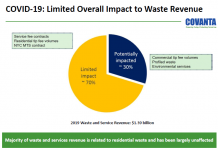Jim Lane
The US Ethanol Fleet reinvents as super-advanced technologies target the old fleet for new purposes.

Ethanol Plant Photo via BigStock
|
For some time, perhaps one of the toughest assets to manage in the Western World possibly the Milky Way Galaxy or even the local galaxy group has been a starch ethanol plant. They’ve been through it all, just about.
Food vs fuel, indirect land-use change, the ethanol blend wall, attacks on the RFS from cattle and dairy interests, attacked on ethanol tax credits, a turbulent relationship with the oil refining industry not to mention, occasionally upside-down economics, rising input costs, and tough times ahead for E15, E30 blender pumps and E85 as a platform.
But they are here and increasingly, the advanced biofuels industry is seeing them as a diamond-like deployment asset. We looked at that phenomenon, in prospect, some time ago in the Bioenergy Project of the Future Series in which we outlined that step one in creating a Project of the Future was “buy or partner with a corn ethanol plant.” But it’s no longer theory, it’s becoming solid reality.
The most popular technologies that are targeting the corn ethanol fleet?
1. Feedstock switching. Sorghum as the new corn?
As we saw in “The New Milo-naires: Corn, Milo and the Biofuels Market’s Invisible Hand”.
Aemetis (OTC:AMTX) operates a 60 mgy corn ethanol plant which imported milo from Argentina in Q4 2012 at a cost savings of about $0.90 per bushel under corn. They require approximately 22 million bushels per year at capacity, so the milo savings are more than $18 million per year.
Add $18 million to the $24 million per year AB RIN’s, subtract about $8 million for the increased cost of biogas, and the net increase in cash flow is about $34 million per year for the 60 mgy (former) corn ethanol plant operated by Aemetis.
As Aemetis CEO Eric McAfee outlined for shareholders in a conference call just before Christmas: ”[The] market disadvantage for corn ethanol facilities allowed Aemetis to acquire the 60 million gallon per year Keyes ethanol plant near Modesto, California. The plant originally cost $132 million to construct, and was acquired in July 2012 by Aemetis for only about $15 million in cash and approximately 11% of Aemetis fully diluted shares. On an actual cash cost basis for the investors in the Keyes plant, this transaction values Aemetis common stock at about $6 per share.
“Aemetis originally leased the Keyes plant in late 2009, and then retrofitted the plant to implement Aemetis design upgrades at a total cost of about $8 million. The plant was restarted in April 2011.”
2. Advanced extraction and yield technologies.
Just this morning, we heard that Edeniq and Pacific Ethanol (PEIX) entered into an agreement to install Edeniq technology at Pacific Ethanol’s Stockton, California ethanol plant. Pacific Ethanol will install Edeniq’s proprietary Cellunators™ to boost ethanol yields, and will also deploy Edeniq’s patented OilPlus™ corn oil extraction process to increase corn oil recovery.
3. Advanced enzymes.
Our 2012 Biofuels Digest Yield Improvement Award went to Mascoma and Lallemand’s TransFerm enzymes. It’s a bioengineered drop-in substitute for conventional fermenting yeast that lowers costs for corn ethanol producers by alleviating the need to purchase a significant amount of the expensive enzymes currently used in corn ethanol production.
4. Enzymes in corn.
In October, we reported that Syngenta and Plymouth Energy signed an agreement to use Enogen trait technology starting in fall 2013. Syngenta states that when using Enogen trait technology there is no need to use liquid alpha amylase enzyme for dry grind ethanol production.
The technology improves ethanol production while reducing energy, gas and water usage. Syngenta is currently contracting corn growers to grow Enogen corn. Under the agreement, growers will receive a premium price for each bushel of Enogen grain delivered to the ethanol plant.
Another win? Last month, Syngenta signed Bonanza BioEnergy of Garden City will use the revolutionary technology that allows corn to express a robust form of alpha amylase enzyme, the primary enzyme used in dry grind ethanol production to convert starch to sugars. For those reasons, we awarded Enogen corn the Biofuels Digest 2012 New Trait Deployment Award.
Over in Massachusetts, Agrivida has been working hard too. “Agrivida has created a proprietary INzyme molecular engineering technology that allows the renewable chemicals, fuels and other industries to grow a substrate of non-food energy crops that contain dormant enzymes, “said Agrivida’s Dr. Michael Lanahan. “These enzymes accumulate in the energy cropwhich can be corn stover or other grains or plantsand are then activated during processing. This approach adds significant value by greatly reducing pretreatment energy and chemical costs normally associated with glucose conversion.” Agrivida’s engineered energy crops and proprietary low temperature, low cost processes release over 80 percent theoretical glucose yield from cellulosic biomass.
5. Algae co-location and production.
Our 2012 Industrial Symbiosis Award went to Green Plains Renewable Energy (GPRE) and BioProcess Algae as the as the BioProcess Algae project advances from a small pilot system to a 5-acre demonstration including all components systems that lead from CO2 capture through algae growth, harvest, and extraction – it aims at transforming not only the opportunities for algae production, but the potential to transform GPRE’s operating income stream.
6. Switchover to biobutanol.
Gevo (GEVO), Butamax, and Green Biologics are working on these opportunities – though Butamax and Gevo have been more active to date with the US corn ethanol fleet. The opportunity? Take the same corn ethanol feedstock stream, add a relatively low-impact unit for biobutanol production, and produce a $4 molecule instead of a $2 molecule. Payback, say the technology developers, can come within three years.
We looked at the Gevo-Butamax competition in “Gevo vs Butamax: Biofuels’ Montagues and Capulets race for scale with n
ew agreements.”
7. Cellulosic Ethanol add-on
This is the POET-DSM route. Take a 100 million gallon traditinoal ethanol plant in Emmetsburg. Start bringing in the corn stover as well as the corn kernels – add-on some highly cool enzymatic hydrolysis technologies and – voila – you have 25 million gallons of bolt-on production, same grower base, same location. More on the latest with POET-DSM, here.
Disclosure: None.
Jim Lane is editor and publisher of Biofuels Digest where this article was originally published. Biofuels Digest is the most widely read Biofuels daily read by 14,000+ organizations. Subscribe here.








